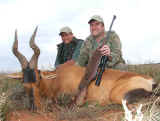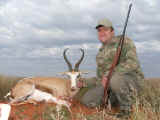Plains Game Hunt in the Free State Province of South Africa
by Chris Troskie
When I started up my pick-up truck that morning I knew that I was in for a hard day’s hunting. On the species list for the day was Kalahari Springbok and Red Hartebeest and although old-time client and friend Dan wasn’t hunting for trophy size, he wanted a good stalk which was most challenging in the area we were hunting. The hunt was taking place in the Luckhoff district of the Free State Province – approximately a 5 hour drive South from Johannesburg International Airport and the terrain consisted mostly of open plains and kopjes (small hills) with hardly any cover to speak of. Whilst the advantage of hunting in this type of terrain is that animals can be spotted from far away, the distinct disadvantage is that it is a lot easier for the animals to see the hunter. Approaching animals to within shooting distances is therefore often problematic.

“Karoo Shrub” and open plains of the Free State – stalking is not easy!”
Dan had brought his Winchester in 7mm Rem Mag along for the hunt – an ideal caliber for this type of terrain because it shoots nice and flat out to 200 yards (and even more). In South Africa, this caliber is often referred to by critics as a “meat master” due to the extensive meat damage that it can cause when shooting at close range but an advantage of using a high velocity caliber for trophy hunting (other than its flat trajectory) is that, provided that well constructed bullets are used and that it hits the target where it should, it is often the result of spectacular one-shot kills and the unfortunate animal that stands in the way of a 150gr projectile flying at 3,110 fps is usually dead before it knows what had hit it.
The game preserve that we were hunting on was 60,000 acres in size and game was plentiful, teeming with Springbok, Black Springbok, Blesbok, Red Hartebeest, Black Wildebeest, Blue Wildebeest and Zebra etc. Finding animals would therefore not present a problem, it was getting close enough for a shot that would be the real challenge…
Because of the difficulty associated to stalking game in such open country, many “hunts” in the area are conducted from hunting cars. Another popular hunting method in this part of the country is the so-called voorsit (ambush) method which involves finding a high-lying spot with some cover and waiting in ambush while beaters on horseback or in vehicles “herd” the animals towards the hunters. Other than when I partake in culling operations I don’t like to shoot from vehicles and although I have “ambush”-hunted previously when hunting for venison, I prefer testing my stalking skills against the animals that I hunt. Today, I was not venison hunting and my job was to give my client a good hunt and get him to within shooting distance of good representatives of the species that he was hunting.
We didn’t drive for long before we saw a herd of between 100 and 150 springbok in the distance. Taking notice of the wind direction, I made a wide circle and drove towards a kopje from where we would start our stalk. I got to the opposite side of the kopje so that it would shield us from the herd and Dan and I got out of the vehicle asking my tracker Phineas to continue driving around the kopje away from the herd of springbok. This would hopefully focus their attention on the vehicle so that we would have an opportunity to get closer to the herd without being noticed. When approaching animals on the final stalk I prefer doing so with as small an entourage as possible as it is difficult enough to stay shielded and find cover from the stares of 150 pairs of eyes when I am alone and that much more difficult to do so when I have a large group of people with me.
The wind was blowing steadily towards us as we crested the kopje and carefully peered over the top. By now Dan and I were flat on our stomachs doing a slow leopard crawl and we glassed the herd carefully to see if there were any shootable specimens amongst them. The herd was some 400 yards away and glassing them through my binoculars I could see that they were staring in the direction of the hunting car which had by now appeared in their view as it came around the kopje, driving diagonally away from them. The distance between us and the herd made it difficult to judge horn length but I did see what appeared to be nice shootable rams.
I was contemplating on the best way to approach the animals when I remembered a tip from the director of the SA National Professional Hunting Academy where I obtained my professional hunter’s qualification. Mel du Plessis – veteran PH and outfitter was giving a lecture on stalking and approaching animals in open terrain when he spoke about the proverbial “sixth sense” that animals seem to have. According to him, animals are much the same as humans when being stared at for long periods of time. “Have you ever been in a situation where you felt that you were being watched and then turned around to find that someone was staring at you?” he said. “Well, the same applies to animals. If you’re going to stare at them for long periods of time you can bet your bottom dollar that they will look up at some point, see you and get away from you as fast as possible.” Mel then related a story about him and his wife walking down a path in the bush one day and seeing an Impala ram standing right in the middle of an intersecting path. From the corner of his eye he saw that the Impala was looking at them and he told his wife to continue walking and not to look directly at the Impala while doing so. They continued walking at the same pace they had been up to then and only occasionally glanced at the Impala – not turning their heads directly to the animal when doing so. According to Mel, they ended up walking right past the animal – the distance between them being less than 30 yards at the closest point and when the Impala saw that the two humans didn’t appear to be interested in him, it continued browsing without paying further attention to the two humans.
I looked at the terrain between us and the springbok and saw that there was a giant ant heap approximately 150 yards from where we were lying to the left of us which would provide cover for us and could also serve as a dead rest for Dan to shoot from. The question was: “How to get there without being spotted?” I weighed up our options… Continuing our leopard crawl towards the termite mound was one option, but would be most uncomfortable and because the only cover en route to the ant heap was “karoo shrub” – about 20 inches high – there was a risk of being spotted. The other option was to stand up and walk toward the ant heap which guaranteed that we’d be spotted but, if Mel’s tip was genuine, this was the ideal time to put it to the test.
I turned towards Dan who was still looking at the herd through his binoculars. “Dan listen carefully now”, I said “I want you to get up with me and walk right behind me towards that ant heap over there. Whatever you do, don’t look at the Springbok and just continue walking with me without making any sudden movements.” Dan didn’t ask any questions and after looking for one last time at the herd to check that their attention was still focused on the vehicle, we slowly got up and started walking purposefully towards the ant heap. The Springbok only became aware of our presence when we had covered about fifty yards, but when the first one saw us; all of them suddenly looked up. My heart sank into my hunting boots and I expected them to run off at anytime. But we persevered and continued walking as if we were totally oblivious of them. I stopped walking the moment that the ant heap was between us and the springbok and immediately crouched down behind the heap, telling Dan to do the same. After about two minutes – which felt more like two hours at the time – I carefully peered around the heap (not over the top) and let out a silent sigh of relief when I saw that, although the Springbok were still staring in our direction, they hadn’t moved – probably waiting for us to appear again. I decided to wait for a couple of more minutes. We had covered quite a bit of ground whilst walking towards the mound but we had walked at an angle and the distance towards the herd (according to Dan’s Leica rangefinder) was still 300 yards. When the springbok didn’t see us appearing again, they continued grazing and I was surprised to see that they were slowly moving towards us. I told Dan to get ready and I started looking for a presentable ram. From this distance I could see at least five shootable rams but they were bunched together with the rest of the herd and we could not shoot at any one of them due to the risk of hitting animals behind it. Then I saw the ram that had Dan’s name written all over it. A 14 incher had separated itself from the bundle… I had hunted with Dan for many years and knew that he was more than capable of shooting from this distance. The ram now was about 240 yards away from us, slowly but surely closing the gap between us. “Do you see the one moving to the right?” I asked Dan and he nodded “Well, when you are ready you can take it.”
There was no doubt that the 175gr Hornady Interlock had found its target. The ram jumped straight up into the air as the bullet struck and was probably dead before it hit the ground. The other animals in the herd heard the shot but, because we remained lying down and out of sight, did not know where the shot came from and they milled around – sniffing the air in an attempt to find out where the danger was. I waited a couple of more minutes before calling Phineas on the radio and asked him to turn back. The springbok only moved off when they saw the approaching vehicle at which point Dan and I got up and walked towards where the buck had fallen.
It was a nice buck and I estimated both horns to measure 14” – a fact that was later confirmed in the skinning shed. Although this was a “green” measurement and the horns would still shrink a little, Dan was satisfied – having worked hard for his animal and hunting it the way it was intended – on foot.
“Dan’s 14” Kalahari Springbok”
Later that day, we spotted a Red Hartebeest male which was standing on its own and Dan used his Winchester to kill it with a well-placed shot from approximately 270 yards. This hunt also presented quite a challenge but more about that on another day…

“Dan’s Red Hartebeest bull taken from 270 yards. The author is on the left”
Chris Troskie
Rifle and Reel Africa Safaris
South Africa
www.rifleandreel.com
